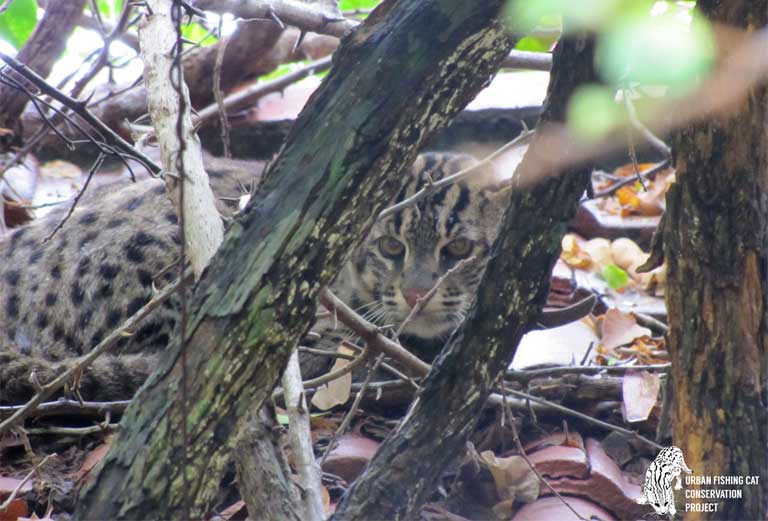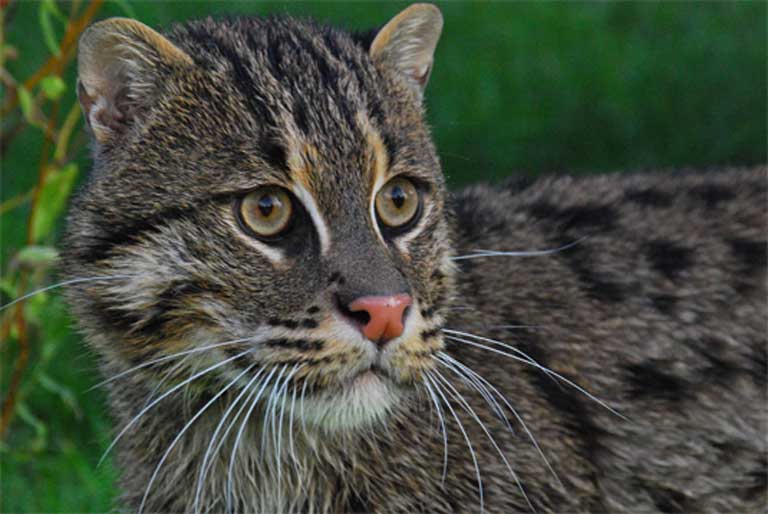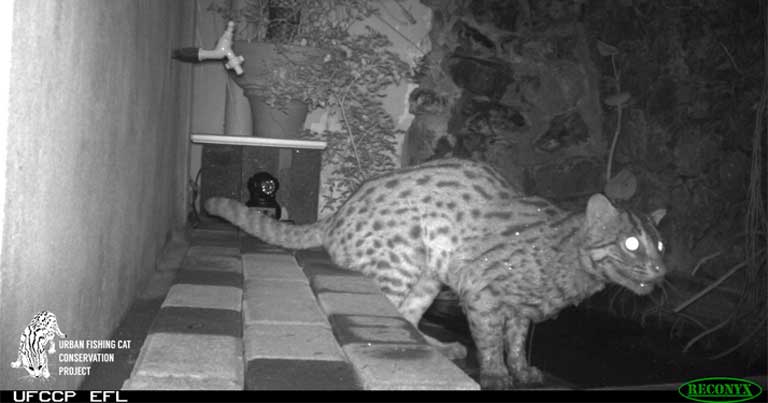- Fishing cats have a broad but discontinuous range, including wetland areas of mainland Asia (India, Nepal, Bangladesh, Myanmar, Thailand, Vietnam, Cambodia, and perhaps Malaysia), as well as the islands of Sri Lanka and maybe Java. But these small nocturnal wild cats are rarely seen. Habitat loss has caused a drastic decline, and as few as 3,000 may remain in the wild.
- Fishing cats are prestigious swimmers, love the water, and eat mostly fish, but they also eat just about anything that they can catch, including birds, snakes, frogs, insects, terrestrial mammals such as civets and rodents, along with domestic livestock such as ducks and chickens.
- While primarily wetland species, Fishing cats have recently proven to be quite adaptable, and the animals have been discovered making night time raids on fishponds in the highly urbanized city of Colombo, Sri Lanka, population 650,000+.
- The major block to Fishing cat conservation is that it is almost unknown to the public and to funders. The animals are almost never seen in the wild, but researchers who have spent time with Fishing cats say that this species’ time in the public limelight could be on the verge of occurring.

Say the word “cat” and it’s unlikely the words “water” or “swimming” spring quickly to mind. But both are essential to the lifestyle of Asia’s Fishing cat (Prionailurus viverrinus). Short, powerfully built and about double the size of a domestic house cat, the Fishing cat is unusual among its kind. It’s utterly at home in Asian wetlands and in the water. And, yes, it is an excellent swimmer.
But unfortunately for this unusual animal, it and its habitat are under severe threat. In Southeast Asia, for example, where P. viverrinus once commonly roamed, over 45 percent of protected wetlands and 94 percent of globally significant wetlands are threatened, according to the IUCN.
These nocturnal animals are strongly associated with wetlands, and typically found (if they can be found at all) among the dense grasses of swamps, marshes, reed beds, around oxbow lakes, tidal creeks, mangrove forests, and wet areas scattered across India, Southeast Asia, on Sri Lanka and maybe Java. There are no confirmed records of Fishing cats on the Malaysian Peninsula, but a 1999 camera trap photo showing just the animal’s hindquarters, suggests the species occurs there.
The Fishing cat’s diet, as its name suggests, is made up primarily of fish, and it often uses its paws to mimic the movement of insects above the water to attract its prey. A study of scat in India’s Keoladeo National Park found that fish comprised 76 percent of the Fishing cat’s diet there. But P. viverrinus is no picky eater. Fishing cats are known to hunt birds, snakes, frogs, insects, terrestrial mammals such as civets and rodents, along with a range of domestic animals. In fact, its taste for ducks, chickens and other livestock often gets it into trouble.

In 2008, the IUCN up-listed the Fishing cat from Vulnerable to Endangered. It’s estimated that there are only around 3,000 of these shy and elusive creatures left in the wild, and it is quite possible that the species is extinct across a good part of its range, although this remains unverified and far from certain. That being the primary conservation challenge regarding the Fishing cat: you can’t save an animal if you don’t know where it is, or are forced to guess its day-to-day habits and behaviors.
On the trail of the mysterious Fishing cat
In 1994, a team of scientists surveying river otters inadvertently captured evidence of the Fishing cat on the Indonesian island of Java. The scant data uncovered by the team led them to suggest that the Javan Fishing cat — due to its geographical isolation — ought to be recognized as a sub-species (Prionailurus viverrinus rizophoreus) and that it should be listed as Critically Endangered.
Fast-forward to today, and little more is known about this enigmatic Javan population. No one has seen a trace of it, and nobody even knows whether it still exists.
The case of the Javan Fishing cat is characteristic of the species as a whole. Its image may be caught by a game camera here, or reported by a disgruntled farmer there, or its skin may turn up in a rural wildlife market. But long-term studies of the species in the wild remain few, and knowledge about the species is scant.
“We often know the range for lots of different species, and we take that for granted. At least we know more or less where a species is found,” said Anthony J. Giordano, director and founder of S.P.E.C.I.E.S, the Society for the Conservation of Endangered Carnivores and their International Ecological Study. “For Fishing cats, one of the most enigmatic things about them is their distribution.”
The cat is discontinuous across its range, he explained, popping up here and there, often without any known bridges connecting populations.

This expansive, but scattered range encompasses much of mainland Asia, including the foothills of the Nepalese Himalayas, wetland areas of India and Southeast Asia (includes the countries of Cambodia, Myanmar and Thailand, and maybe Malaysia). Then there’s that mysterious island population on Java. Unfortunately, in many cases, sightings are many years old, leaving scientists not only unsure where the species is, but also where it isn’t. In Vietnam, for instance, “we’re not even sure it exists anymore,” admitted Jim Sanderson, founder of the Fishing Cat Working Group.
The mystery of the Fishing cat’s whereabouts resulted in Sumatra being listed within its range for many years. According to Sanderson this mistake dates back to the 1940s. He studied camera trap images of suspected Fishing cats on the island, and all of them turned out to be Leopard cats. As a result of that study, he suggested Sumatra be removed from the Fishing cat’s geographical range.
The Javan Fishing cat, though nearly as much a mystery, is a different story. “We knew it was there because we had pictures of it,” said Sanderson in a mongabay.com interview. But since 1994 there have been no confirmed sightings despite numerous camera trapping operations across Java. As on Sumatra, there has been confusion caused by misidentification, due to the difficulty in telling the Fishing cat from its Leopard cat cousin.
Wanting to confirm or deny the Javan Fishing cat’s existence, Giordano recently completed a crowdfunding campaign to launch a definitive search for it. “I always had it in my head that eventually I’d try to investigate what’s happening with them. Have they slid into extinction? Are they still there?” he wonders.

If the Fishing cat is still on Java, its survival depends on its ability to adapt rapidly to a changing environment where wetlands are disappearing, said Giordano. But that crucial question too has a question mark hanging over it: just how resilient is the Fishing cat as a species? “I feel like I’m betting on that, for this particular project,” Giordano confided. “If the Fishing cat is there, it’s because of its ability to adapt to [changing and diverse] landscapes.”
The resilient and adaptive Fishing cat
A partial answer to the resiliency question comes as Mizuchi climbs cautiously up and over a garden wall. Stalking stealthily, he approaches an urban backyard fishpond, his eyes glowing due to the surveillance camera trap’s night vision.
He leans out over the pond, comfortable in his cloak of darkness, not realizing that he is being watched by the mechanical eye. In an instant he’s scooped out a Butterfly Koi, worth some 10,000 rupees per fish (around US$60-100).
The fish securely clamped between his jaws, Mizuchi wanders off into the night.
Caught on film during one of his night raids in Colombo, Sri Lanka — a city of roughly 650,000+ people — Mizuchi is a rare find, and he causes scientists to scratch their heads. This P. viverrinus is a Fishing cat thriving not in an isolated rural wetland but within the hustle of a large Asian city.
This urban Fishing cat story starts back in 2006, when Eric Wikramanayake and other researchers were first told about a leopard-like cat wandering the urban sprawl of Colombo. They quickly realized that the mysterious nocturnal species was in fact a Fishing cat, but their efforts to study the Endangered animal were brought to a halt with the flaring of Sri Lanka’s civil war.
Now, Anya Ratnayaka has taken up the research mantle and leads the Urban Fishing Cat Conservation Project. She has found that the cats, though widely known as wetland specialists, seem to hold a particular affinity for the city.


Her research has been centered around the radio collaring of Fishing cats, and then observing their movements. One remarkable surprise: after capturing a few of the animals, and then releasing them into a wetland, the cats — seemingly unhappy at being deposited in their natural habitat — made their way back to urban Colombo.
“That’s when we kind of realized that these cats aren’t just [living] in the wetlands!” she said. To her surprise, the scientific team even found Fishing cats living in the heart of the city. One was found residing in Colombo Five, a primarily residential area nowhere remotely close to a wetland.
“There is no natural habitat anywhere there!” She exclaimed. “And that was this cat’s territory.” The non-wetland Fishing cat in question was the infamous Mizuchi, the Carp Koi thief. Ratnayaka’s team even found Fishing cats living on the rooftops of houses, where they feast on civets that live in attics.
Such adaptive behavior is not only confined to Sri Lanka. In the Terai region of Nepal, Sagar Dahal and his research team found a Fishing cat that was using a community pond located in the middle of a small town as its hunting ground. In fact, Fishing cats have been identified as the predators scouring numerous commercial fishponds across the region.
Double threat: poaching and habitat loss
Unfortunately for the Fishing cat, this new niche and proximity to humans puts it at high risk.
“We found the hide of a Fishing cat in the house of a local farmer,” Sagar revealed, and the researcher suspects farmer retaliation as the motive. Sadly, for Fishing cats, this cause of death may be trending higher across the species’ range. As cultivated land offers up an easy meal, Fishing cats come into conflict with traditional and aquaculture farmers.
The severity of poaching varies across the Fishing cat’s range. In Sri Lanka, for instance, direct killing is not a significant problem according to Ratnayaka. If we move to Thailand, however, a 2015 study showed that the cats are targeted as both a pest species and for consumption. Similarly, in both India and Myanmar, Fishing cat pelts have appeared in illegal wildlife markets.

But transformation of wetlands remains the major threat facing the Fishing cat. Wetland areas across Asia have been settled on and degraded, or are under threat as they are converted to make way for aquaculture in the form of shrimp farms or rice paddies.
This agricultural conversion doesn’t necessarily mean doom for the cat, as the animals can find plentiful food on croplands and in fishponds. But the permanent loss of their habitat has drastically reduced their numbers. “There appears to have been a severe decline in the Fishing cat population throughout much of its Asian range over the last decade,” writes the IUCN.
No one pays the way for small cats
A major stumbling block to the conservation of the Fishing cat and other smaller cat species: lack of funding. Most research and preservation money goes to tigers, lions, leopards — to the big charismatic cat species, and not to their more diminutive relatives. It’s a theme all of the Fishing cat specialists interviewed agree upon, and it’s a problem no one knows how to solve easily.
“I’ve had an email come back [from a potential funder] that says ‘sorry but your species just isn’t important enough for the funding’,” Ratnayaka said. “That’s kind of like a blow to you, because they are an Endangered Species.” In search of local funding, she often runs up against a lack of interest and a lack of understanding, stemming partly from ignorance of what a Fishing cat actually is.
Of course, “the moment you say ‘leopard’ [those same people] will give you all the money you want!” Ratnayaka laments.
The absence of the Fishing cat from funder radar screens means that one of the greatest conservation challenges the species faces is receiving sufficient research dollars to learn more about it. Ratnayaka’s small-scale project, for example, has only been able to radio collar four cats; not nearly enough in her scientific opinion to get robust research results. She needs to collar at least 15 to gather sufficient data, but high tech equipment doesn’t come cheap.

In Giordano’s case, a search for Javan fishing cat research dollars came to nought when he went through the normal funding channels. After a few years struggling to launch his project, he decided to try crowdfunding. And after a lot of effort, it worked. But he concludes that crowdfunding for smaller species, such as the Fishing cat, is not a “silver bullet,” though it remains a useful option. It’s still necessary — if the species is to be saved — to get the big funders on board.
In Giordano’s view the large conservation funders are standoffish because they want to see a big “pay-off” and return on their investment. That sort of guaranteed result and public attention is challenging when it comes to Javan Fishing Cat research — especially seeing as there is no absolute certainty that the animals even exist there in the wild. So for Giordano that “giant question mark” wards off potential donors rather than attracting them.
Still, things aren’t as bleak as they were five years ago, according to Sanderson. “Definitely, the amount of money that has gone into Fishing cats is more than it’s ever been in the past,” he said.
One strategy for conserving the Fishing cat is to bring it into the mainstream of conservation consciousness. But can this small, evasive cat compete with its bigger, charismatic cousins? Anya Ratnayaka thinks so: she notes that it may be a small feline, but it’s got one hell of a personality, that with some good PR might catch the public imagination.

The Fishing cat, she notes, is a cat with attitude and swagger: confident, stealthy and versatile enough to navigate both the wetland and urban environments. It’s a species worth studying and conserving. It’s a bold cat too: when scientists try to catch them, Ratnayaka says, Fishing cats don’t run, they play games.
Get to know the Fishing cat, and you will find them to be fascinating and endearing, she argues: “If I had to pick between the leopard and the Fishing cat, I’d pick the Fishing cat… Just watching them in the wild, they have so much more ‘oomph.’”
The Almost Famous Fishing cat conundrum
Like all the animals profiled in this Mongabay series, the Fishing Cat’s ultimate conservation challenge is overcoming its Almost Famous status. But according to Sagar Dahal the Fishing cat is lurking just “behind the curtain” and well overdue to make its public debut.
“They are a somewhat marginalized species in the animal world, like a marginalized community,” he told Mongabay. “People don’t know what a Fishing cat is, but everyone knows about the tiger and the rhino… People don’t know much about the Fishing cat; what it looks like, what it eats.”
Above all, it’s this PR hurdle that needs to be jumped — then maybe finally, the Fishing cat will be able to join its domestic feline cousins as a youtube and facebook celebrity, and earn the big conservation bucks now reserved for tigers and leopards.

Wetlands across Asia are rapidly vanishing, and as they go, so may go the Fishing cat. But greater public knowledge of their existence could also help save their disappearing home territory: if people knew, for example, that within a particular undervalued wetland slated for development, there lived an enigmatic and Endangered charismatic feline species, that might offer just enough incentive to tip the balance and preserve both the habitat and the Fishing cat.
But for this to happen, people first need to know about the Fishing cat, and learn about its peculiar ways. And perhaps most of all, they need to know if it’s even out there in the first place. Then the Fishing cat can finally emerge from behind the curtain, and enter the limelight just long enough to gain some desperately needed funding and, maybe, snatch a fish.
With a little luck, the Fishing cat could be pestering urban and rural fish keepers for a long time to come.
